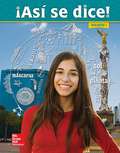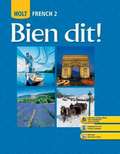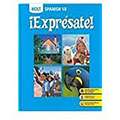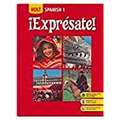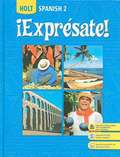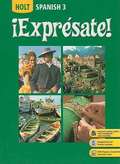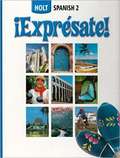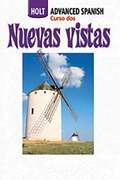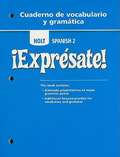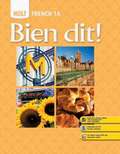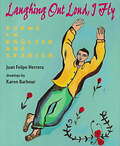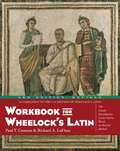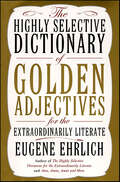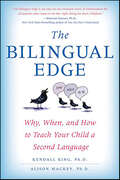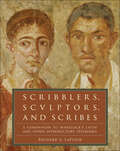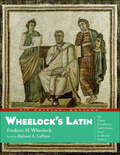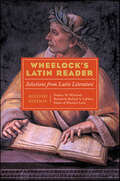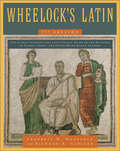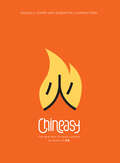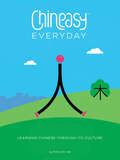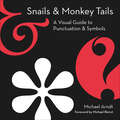- Table View
- List View
Asi Se Dice! Level 1 (Asi Se Dice)
by Conrad J. SchmittThis is the textbook for level 1 of the popular Spanish language learning series
California Tesoros de lectura: Lectura/Artes del lenguaje [Grade 1, Volume 3]
by Jana Echevarria David J. Francis Elva DuránNIMAC-sourced textbook
Texas Tesoros de Lectura 2.2: Lectura/Artes del lenguaje
by Elva Duran Jana Echevarría David J. Francis Irma M. Olmedo Gilberto D. Soto Josefina V. TinajeroA Spanish Language Arts Book.
Holt French 2, Bien dit!
by John Demado Marie Ponterio Robert Ponterio Séverine ChampenyNIMAC-sourced textbook
Holt Spanish 1B, iExpresate!
by Ana Beatriz Chiquito John Mcminn Nancy Humbach Stuart Smith Sylvia Madrigal VelascoNIMAC-sourced textbook
Holt Spanish 1, ¡Expresate!
by Ana Beatriz Chiquito John Mcminn Nancy Humbach Stuart Smith Sylvia Madrigal VelascoNIMAC-sourced textbook
Holt Spanish 2, ¡Exprésate!
by John Mcminn Nancy Humbach Stuart Smith Sylvia Madrigal VelascoNIMAC-sourced textbook
¡Exprésate! Holt Spanish 2 (¡Exprésate! Ser.)
by Nancy Humbach Stuart Smith Sylvia VelascoNIMAC-sourced textbook
Holt Advanced Spanish, Curso dos Nuevas vistas
by Holt, Rinehart and Winston StaffNIMAC-sourced textbook
¡Exprésate! Holt Spanish 2, Cuaderno de vocabulario y gramática
by Holt, Rinehart and Winston StaffNIMAC-sourced textbook
Holt French: 1A (Bien Dit!)
by Marie Ponterio Robert Ponterio Séverine Champeny John DeMadoNIMAC-sourced textbook
Laughing Out Loud, I Fly: A Carcajadas Yo Vuelo
by Juan Felipe HerreraA collection of poems in Spanish and English about childhood, place, and identity.
The Generation of 1898 and After
by Beatrice P. Patt Martin NozickThe purpose of this anthology is to acquaint students of Spanish with some of the best writing of twentieth-century Spain. The writers known traditionally as the Generation of 1898 are presented first, beginning with Angel Ganivet and ending with Azorin, who is still alive at the time of this writing. The established figures of this generation are, we believe, represented in this text by some of their most characteristic pages.
Workbook for Wheelock's Latin (3rd edition, revised)
by Paul T. Comeau Richard A. LafleurWorkbook associated with the classic text Wheelock's Latin
The Highly Selective Dictionary of Golden Adjectives: For the Extraordinarily Literate (Highly Selective Reference)
by Eugene EhrlichAdjectives have long suffered from bad press. For many years, English teachers have been fond of telling students that "adjectives are the enemy of nouns, and adverbs are the enemy of everything else."While it's still advisable to heed your English teacher's advice on most other matters, The Highly Selective Dictionary of Golden Adjectives for the Extraordinarily Literate proves that breaking certain rules can make written and spoken language that much livelier, adding much-needed color, style, and adornment. With this addition to the popular Highly Selective series, the "golden" adjective, at last, gets the star treatment it deserves. From adventitious to zaftig, renowned lexicographer Eugene Ehrlich has collected more than 850 of the most interesting and engaging adjectives in the English language and has provided concise definitions and instructive usage examples. Whether you're a writer, a speaker, or a word buff, this compendious, trenchant, laudable, and all-around fantabulous volume will help you put panache back into your prose.
The Bilingual Edge: Why, When, and How to Teach Your Child a Second Language
by Alison Mackey Kendall King“An easy-to-use treasure trove of information” for parents who want to help their children learn a new language (Deborah Tannen, PhD, New York Times–bestselling author of You Just Don’t Understand).Parents spend millions of dollars every year on classes, computer programs, and toys, all of which promise to help children learn a second language. They want their kids to have the lifelong cultural and intellectual advantages that come from being bilingual—but many of their best efforts (and investments) end in disappointment.In The Bilingual Edge, Georgetown linguistics professors and parents Kendall King and Alison Mackey wade through the hype and provide clear insights into what actually works. No matter what your language background is—whether you never passed high school Spanish or you speak Mandarin fluently—King and Mackey will help you:select the language that will benefit your child the mostfind materials and programs that will assist your child in achieving fluencyidentify your family’s unique traits and use them to maximize learningFancy private schools and expensive materials aren’t needed. Instead, The Bilingual Edge translates the latest research into interactive strategies and quick tips that even the busiest parents can use.
Scribblers, Sculptors, and Scribes: A Companion to Wheelock's Latin and Other Introductory Textbooks
by Richard A. LaFleurAn outstanding and enjoyable companion reader to the Wheelock’s curriculum, or any introductory Latin textbook.From one of the country’s leading Latinists, this reader is the perfect complement to any Latin program, and the first collection of entirely authentic classical Latin texts that beginning students, from the very first day of their introduction to Latin, can read and enjoy.Beginning with simple graffiti, Scribblers, Sculptors, and Scribes moves toward longer inscriptions and literary texts as students progress. Designed to accompany the bestselling Wheelock’s curriculum, its 40 chapters are linked with the 40 chapters of Wheelock’s Latin, but the book’s readings and design features make it suitable for use alongside any introductory college or high-school Latin textbook. Packed with hundreds of actual Latin inscriptions, proverbs, and texts, this outstanding textbook also includes dozens of photos and illustrations, maps, discussion and comprehension questions, grammar capsules, a Latin–English vocabulary section, a summary of forms, and much more.
Wheelock's Latin: The Classic Introductory Latin Course, Based on Ancient Authors
by Frederic M. WheelockThe classic introductory Latin textbook, first published in 1956, and still the bestselling and most highly regarded textbook of its kind.Revised and expanded, this sixth edition of classics professor Frederic M. Wheelock's Latin has all the features that have made it the bestselling single-volume beginning Latin textbook and more:* Forty chapters with grammatical explanations and readings based on ancient Roman authors* Self-tutorial exercises with an answer key for independent study* An extensive English-Latin/Latin-English vocabulary section* A rich selection of original Latin readings—unlike other textbooks which contain primarily made-up Latin texts* Etymological aidsAlso includes maps of the Mediterranean, Italy and the Aegean area, as well as numerous photographs illustrating aspects of classical culture, mythology, and historical and literary figures presented in the chapter readings.
Wheelock's Latin Reader: Selections from Latin Literature
by Frederick M. WheelockOriginally intended by Professor Frederic M. Wheelock as a sequel to Wheelock's Latin, his classic introductory Latin textbook, Wheelock's Latin Reader, newly revised and updated by Richard A. LaFleur, is the ideal text for any intermediate-level Latin course. You'll find a rich selection of of prose and poetry from a wide range of classical authors, as well as briefer passages from medieval and Late Latin writers, each presented in the Latin in which it was originally written. Useful features include extensive notes; a complete Latin-English vocabulary; maps of ancient Italy, Greece, and the Roman Empire; and numerous photographs illustrating aspects of classical culture, mythology, and history featured in the readings.
Wheelock's Latin 7th Edition
by Richard A. LafleurFor nearly sixty years, Wheelock's Latin has remained the opitmus liber of beginning Latin textbooks. When Professor Frederic M. Wheelock's Latin first appeared in 1956, the reviews extolled its thoroughness, organization, and conciseness; one reviewer predicted that the book "might well become the standard text" for introducing students to elementary Latin. Now, nearly six decades later, that prediction has certainly proved accurate.This new edition of Wheelock's Latin has all of the features, many of them improved and expanded, that have made it the bestselling single-volume beginning Latin textbook: 40 chapters with grammatical explanations and readings drawn from the works of Rome's major prose and verse writers; Self-tutorial exercises, each with an answer key, for independent study; An extensive English-Latin/Latin-English vocabulary section; A rich selection of original Latin readings--unlike other Latin textbooks, which contain primarily made-up texts; Etymological aids, maps, and dozens of images illustrating aspects of the classical culture and mythology presented in the chapter readings. Also included are expanded notes on the literary passages, comments on vocabulary, and translation tips; new comprehension and discussion questions; and new authentic classical Latin readings, including Roman graffiti, in every chapter. <P><P><i>Advisory: Bookshare has learned that this book offers only partial accessibility. We have kept it in the collection because it is useful for some of our members. To explore further access options with us, please contact us through the Book Quality link. Benetech is actively working on projects to improve accessibility issues such as these.</i>
Chineasy: The Easy Way to Learn Chinese
by ShaoLan HsuehChinese is considered one of the most difficult languages to master. However, using the Chineasy system, anyone can begin to understand and read Chinese. It works by transforming Chinese characters into illustrations to make them easy to remember. This book teaches the key characters on which the language is built and how these characters can be combined to form more complex words and phrases. Learning Chinese has never been this simple or more fun!
Chineasy Everyday: Learning Chinese Through Its Culture
by ShaoLanThe New Way to Read ChineseShaoLan Hsueh, a Taiwanese entrepreneur based in London, couldn’t find an effective way to teach her children Chinese, so she developed a groundbreaking visual method to make reading characters fun and easy. By learning the most commonly occurring characters—the building blocks of the entire language—readers of all ages can swiftly grasp basic concepts and words.Chineasy Everyday teaches more than four hundred of the most useful Chinese characters, phrases, and sentences. Organized into eleven themes that reflect daily life, this book brings the stories and myths behind the characters to life, providing a unique perspective into Chinese history and culture.“These cute images make reading Chinese characters ‘Chineasy.’”—NPR’s “Code Switch” blog“In her delightful book...Hsueh offers an inspired approach to learning more than four hundred Chinese characters.”—San Francisco Chronicle blog
Snails & Monkey Tails: A Visual Guide to Punctuation & Symbols
by Michael Arndt"There are countless books that can teach you the alphabet, but almost none that focus on the tiny designs that run interference among the letterforms: those easily overlooked punctuation and typographic symbols. These symbols, as Michael Arndt proves in this beautiful and endlessly fascinating book, are absolutely indispensable to communication: punctuation turns words into sentences and language into meaning... From commas to semicolons, from slashes to asterisks, from guillemets to octothorpes (named, perhaps, after athlete Jim Thorpe), you’ll never look at punctuation the same way again."—Michael Bierut, partner, PentagramIn this show-stopping guide with more than 75 uniquely designed two-color spreads—a rollicking linguistic ride for fans of Eats, Shoots & Leaves and Just My Type—award-winning graphic designer Michael Arndt explores the typographic origins, names, and shapes of both common punctuation marks and symbols, as well as the proper and diverse usage of each.From the period to the question mark, the semicolon to the em dash, symbols and marks are an integral part of language. In graphically engaging spreads that utilize typography in an innovative way, Snails & Monkey Tails examines the evolution of these mighty linguistic tools—from the punctum, or point, created by an ancient scribe to the guillemet, used most commonly in lieu of quote marks by the French (and named in honor of a typographer Guillaume Le Bé). With verve and insight, Michael Arndt explains their proper usage and how they came to be universally accepted today. Snails & Monkey Tails—Snails (@); Monkey Tails (&)—is packed with intriguing facts, history, stories, and lore, as well as grammar, explaining it clearly and with examples. What is the purpose of the comma—perhaps the most used symbol in the English language—and what are the proper uses of the asterisk? Do quote marks go inside or outside punctuation? What about a quote within a quote—a quote from someone quoting someone else? How much space goes on either side of an ellipsis? What’s the difference between an en-dash and an em-dash? Complete with a listing of useful terms and clear diagrams for creating typographical marks and symbols correctly on both PC and Apple computers, Snails & Monkey Tails is essential for bibliophiles, writers, grammarians, graphic designers, typography enthusiasts, logophiles, and anyone with a passion for the written word.
